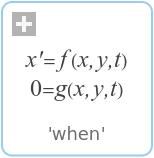WOLFRAM SYSTEM MODELER
'when'when |
|
Wolfram Language
SystemModel["ModelicaReference.'when'"]

Information
This information is part of the Modelica Standard Library maintained by the Modelica Association.
Activate equations or statements when condition becomes true
Examples
equation
when x > 2 then
y3 = 2*x +y1+y2; // Order of y1 and y3 equations does not matter
y1 = sin(x);
end when;
y2 = sin(y1);Syntax
In equation sections:
when expression then
{ equation ";" }
{ elsewhen expression then
{ equation ";" } }
end whenIn algorithm sections:
when expression then
{ algorithm ";" }
{ elsewhen expression then
{ algorithm ";" } }
end whenDescription
The expression of a when clause shall be a discrete-time Boolean scalar or vector expression. The equations and algorithm statements within a when clause are activated when the scalar or any one of the elements of the vector expression becomes true. When-clauses in equation sections are allowed, provided the equations within the when-clause have one of the following forms:
- v = expr;
- (out1, out2, out3, ...) = function_call(in1, in2, ...);
- operators assert(), terminate(), reinit()
- For and if-clause if the equations within the for and if-clauses satisfy these requirements.
- In an equation section, the different branches of when/elsewhen must have the same set of component references on the left-hand side.
- In an equation section, the branches of an if-then-else clause inside when-clauses must have the same set of component references on the left-hand side, unless the if-then-else have exclusively parameter expressions as switching conditions.
A when clause shall not be used within a function class.
[Example:
Algorithms are activated when x becomes > 2:
when x > 2 then
y1 := sin(x);
y3 := 2*x + y1 + y2;
end when;Algorithms are activated when either x becomes > 2 or sample(0,2) becomes true or x becomes less than 5:
when {x > 2, sample(0,2), x < 5} then
y1 := sin(x);
y3 := 2*x + y1 + y2;
end when;For when in equation sections the order between the equations does not matter, e.g.,
equation
when x > 2 then
y3 = 2*x +y1+y2; // Order of y1 and y3 equations does not matter
y1 = sin(x);
end when;
y2 = sin(y1);The needed restrictions on equations within a when-clause becomes apparent with the following example:
Real x, y;
equation
x + y = 5;
when condition then
2*x + y = 7; // error: not valid Modelica
end when;When the equations of the when-clause are not activated it is not clear which variable to hold constant, either x or y. A corrected version of this example is:
Real x, y;
equation
x + y = 5;
when condition then
y = 7 - 2*x; // fine
end when;Here, variable y is held constant when the when-clause is de-activated and x is computed from the first equation using the value of y from the previous event instant.
For when in algorithm sections the order is significant and it is advisable to have only one assignment within the when-clause and instead use several algorithms having when-clauses with identical conditions, e.g.,
algorithm
when x > 2 then
y1 := sin(x);
end when;
equation
y2 = sin(y1);
algorithm
when x > 2 then
y3 := 2*x + y1 + y2;
end when;Merging the when-clauses can lead to less efficient code and different models with different behaviour depending on the order of the assignment to y1 and y3 in the algorithm.]
A when clause
algorithm
when {x>1, ..., y>p} then
...
elsewhen x > y.start then
...
end when;is equivalent to the following special if-clause, where Boolean b1[N] and Boolean b2 are necessary because the edge() operator can only be applied to variables
Boolean b1[N](start={x.start>1, ..., y.start>p});
Boolean b2(start=x.start>y.start);
algorithm
b1:={x>1, ..., y>p};
b2:=x>y.start;
if edge(b1[1]) or edge(b1[2]) or ... edge(b1[N]) then
...
elseif edge(b2) then
...
end if;with "edge(A)= A and not pre(A)" and the additional guarantee, that the algorithms within this special if clause are only evaluated at event instants.
A when-clause
equation
when x>2 then
v1 = expr1 ;
v2 = expr2 ;
end when;is equivalent to the following special if-expressions
Boolean b(start=x.start>2); equation b = x>2; v1 = if edge(b) then expr1 else pre(v1); v2 = if edge(b) then expr2 else pre(v2);
The start-values of the introduced Boolean variables are defined by the taking the start-value of the when-condition, as above where p is a parameter variable. The start-values of the special functions initial, terminal, and sample is false.
When clauses cannot be nested.
[Example:
The following when clause is invalid:
when x > 2 then
when y1 > 3 then
y2 = sin(x);
end when;
end when;]
